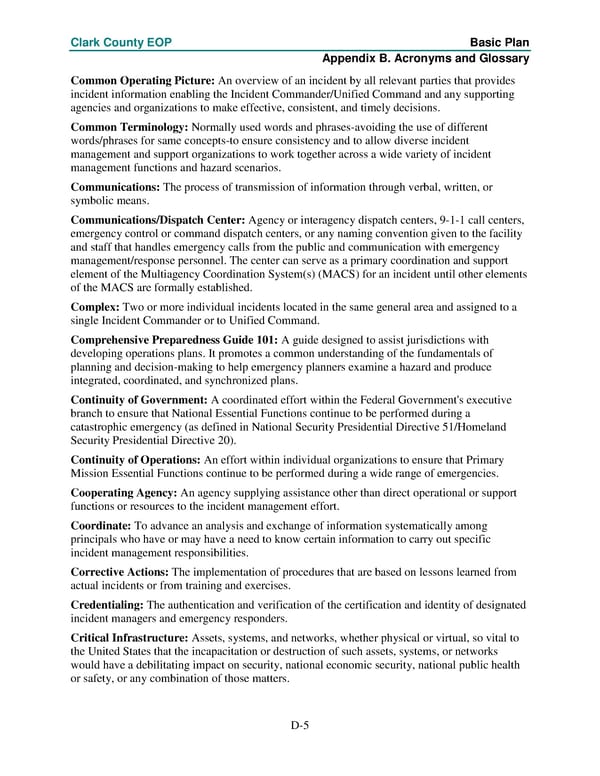Clark County EOP Basic Plan Appendix B. Acronyms and Glossary Common Operating Picture: An overview of an incident by all relevant parties that provides incident information enabling the Incident Commander/Unified Command and any supporting agencies and organizations to make effective, consistent, and timely decisions. Common Terminology: Normally used words and phrases-avoiding the use of different words/phrases for same concepts-to ensure consistency and to allow diverse incident management and support organizations to work together across a wide variety of incident management functions and hazard scenarios. Communications: The process of transmission of information through verbal, written, or symbolic means. Communications/Dispatch Center: Agency or interagency dispatch centers, 9-1-1 call centers, emergency control or command dispatch centers, or any naming convention given to the facility and staff that handles emergency calls from the public and communication with emergency management/response personnel. The center can serve as a primary coordination and support element of the Multiagency Coordination System(s) (MACS) for an incident until other elements of the MACS are formally established. Complex: Two or more individual incidents located in the same general area and assigned to a single Incident Commander or to Unified Command. Comprehensive Preparedness Guide 101: A guide designed to assist jurisdictions with developing operations plans. It promotes a common understanding of the fundamentals of planning and decision-making to help emergency planners examine a hazard and produce integrated, coordinated, and synchronized plans. Continuity of Government: A coordinated effort within the Federal Government's executive branch to ensure that National Essential Functions continue to be performed during a catastrophic emergency (as defined in National Security Presidential Directive 51/Homeland Security Presidential Directive 20). Continuity of Operations: An effort within individual organizations to ensure that Primary Mission Essential Functions continue to be performed during a wide range of emergencies. Cooperating Agency: An agency supplying assistance other than direct operational or support functions or resources to the incident management effort. Coordinate: To advance an analysis and exchange of information systematically among principals who have or may have a need to know certain information to carry out specific incident management responsibilities. Corrective Actions: The implementation of procedures that are based on lessons learned from actual incidents or from training and exercises. Credentialing: The authentication and verification of the certification and identity of designated incident managers and emergency responders. Critical Infrastructure: Assets, systems, and networks, whether physical or virtual, so vital to the United States that the incapacitation or destruction of such assets, systems, or networks would have a debilitating impact on security, national economic security, national public health or safety, or any combination of those matters. D-5
 Emergency Operations Plan Page 108 Page 110
Emergency Operations Plan Page 108 Page 110